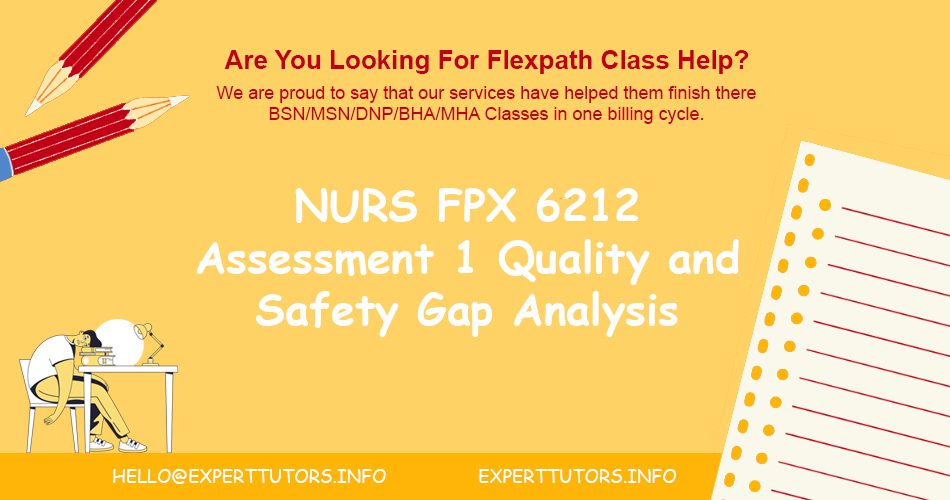Assessment 1: Quality and Safety Gap Analysis
Name
Capella University
FPX 6212
Dr. Name
March, 2024
Quality and Safety Gap Analysis
Conducting a Quality and Safety Gap Analysis is a pivotal method for healthcare facilities to critically examine and enhance the level and safety of their services. This detailed process entails a comparative study between the existing standards of patient care and the optimal, targeted benchmarks. It also involves a thorough investigation into the underlying causes of any discrepancies, emphasizing the formulation of a strategic plan to address and resolve these identified shortcomings. This analytical procedure is a systematic framework for pinpointing areas needing enhanced care quality and safety (Harolds, 2023).
In a case study involving Villa Health Hospital, this evaluation uncovered a significant issue relating to the effectiveness and superiority of healthcare outcomes. An in-depth analysis of this problem led to several operational changes designed to boost patient outcomes’ safety and quality. This assessment also explored how the hospital’s distinctive organizational culture might be influencing these outcomes in terms of quality and safety. The justification for implementing these changes was also thoroughly backed, highlighting the imperative need for their execution. This approach emphasized the importance of continual improvement in healthcare settings and illustrated the complex interplay between organizational culture and healthcare outcomes.
Addressing Systemic Challenges in Healthcare to Enhance Safety and Quality
In the healthcare industry, nurse leaders play a crucial role in organizational assessment, particularly when identifying and addressing systemic issues that may hinder the delivery of high-quality patient care. This task requires a sharp eye for detecting patterns and trends that point to broader organizational-level problems that could negatively impact patient care. Conducting a comprehensive analysis is essential to ensure the safety and quality of healthcare services. At Villa Health Hospital, the quality of patient care has been flagged as a critical systemic issue (Lu et al., 2020). One of the central concerns is the inadequate staffing levels, which not only burdens nurses with increased workloads but also results in longer patient waiting times and increases the risk of mistakes or missed care opportunities.
Another significant challenge identified is the inefficiency of communication systems. Problems such as ineffective patient handover protocols and unclear communication channels are major contributors to delays and errors in patient care. The absence of uniform protocols and policies further exacerbates these issues, leading to inconsistent care practices and increasing the risk of harm to patients. To address the systemic challenges in healthcare, the nurse leader can work with the healthcare team to develop and implement targeted strategies. These strategies may include increasing staffing levels, improving communication systems, providing comprehensive training and development opportunities for staff, updating equipment and technology, and establishing new policies and protocols. These initiatives are not only aimed at resolving existing issues but also at creating an environment of continuous improvement and excellence in patient care.
Addressing Knowledge Gaps in Healthcare
Knowledge gaps in the healthcare sector can lead to suboptimal patient outcomes and inefficient healthcare delivery. These gaps often result from a lack of information and understanding among healthcare professionals. The latest medical research, patient care techniques, new technologies, policies, and regulations are some of the primary areas where knowledge gaps can occur. Healthcare organizations can mitigate these gaps by investing in regular training programs, encouraging participation in continuing education, and fostering a culture of learning among staff (Neely et al., 2022).
Enhancing Quality and Safety Outcomes in Healthcare through Targeted Practice Changes
To improve healthcare quality and safety, organizations can increase staffing levels and provide comprehensive training, foster clear communication, and integrate Electronic Health Records (EHRs) to reduce errors. Medication reconciliation and standardizing procedures are essential for preventing medication-related errors. Clinical decision support tools, checklists, and standardized protocols help healthcare professionals make informed decisions and maintain consistent care standards. The implementation of continuous quality improvement programs ensures persistent monitoring and evaluation of patient outcomes, fostering a culture of continual enhancement and learning within healthcare organizations. These strategies help bridge existing gaps, leading to significant advancements in healthcare quality and safety (Mutonyi et al., 2022).
Assumptions for Proposal
The healthcare improvement proposal assumes that highly skilled and trained staff, advanced communication tools, and medication reconciliation are critical for enhancing patient safety and care quality. By leveraging these interventions, healthcare teams can improve patient outcomes and satisfaction levels while addressing existing quality issues.
Strategizing Practice Changes at Villa Hospital
Implementing practice changes at Villa Hospital involves a strategic approach, focusing on impact assessment, operational feasibility, and resource management. The following steps outline a prioritized roadmap for implementing these changes effectively, ensuring alignment with the hospital’s goals and enhancing patient care quality.
- Recruitment of New Staff: The foremost priority is the recruitment of additional staff. This step addresses the hospital’s most pressing issue – understaffing, which currently leads to prolonged wait times, increased medication errors, staff burnout, and communication breakdowns. By increasing the workforce, the hospital aims to alleviate these challenges and improve the overall quality of care.
- Staff Training and Development: Once the new staff members are onboarded, the next critical step is their training and development. This involves comprehensive training sessions, spearheaded by the head of nurses, focusing on crucial aspects such as medication error prevention and effective communication strategies. In addition, continuous quality improvement programs will be instituted to ensure adherence to nursing best practices and to monitor the effectiveness of these new changes in care delivery.
- Medication Reconciliation Implementation: The third step involves the implementation of a robust medication reconciliation process. This is an essential measure for ensuring accurate medication administration, significantly reducing the likelihood of medication errors. This systematic process is designed to verify that patients receive appropriate medications at the correct dosages, enhancing medication safety.
- Electronic Health Records (EHR) Integration: Finally, the integration of Electronic Health Records (EHR) is prioritized as the fourth step. The implementation of EHRs aims to optimize the management of medication records and prescriptions. By having a detailed, digital record of medications, healthcare professionals at Villa Hospital can make more informed and accurate decisions regarding patient medications, thus reducing the risk of prescription errors.
These prioritized steps are designed not only to address immediate issues but also to lay a foundation for continuous improvement in patient care at Villa Hospital (Young et al., 2024). Each step is interconnected, contributing to a holistic improvement in the hospital’s operational efficiency and care quality.
Enhancing Quality and Safety Outcomes in Healthcare through Strategic Changes
To create a culture of quality and safety in healthcare organizations, it’s important to integrate proposed changes that align with the organization’s values and objectives. This includes assessing the impact of changes on internal communication, collaboration, and existing quality and safety processes. Hiring new staff can address understaffing and reduce workload, increasing patient satisfaction and safety. Adopting technological tools like EHR and medication reconciliation systems can mitigate medication errors and reinforce a culture of high-quality care. These advancements align with the organization’s aim of enhancing quality and safety in healthcare delivery (Wasihun et al., 2024).
Key Criteria for Evaluating Organizational Culture at Villa Hospital
To accurately assess the effectiveness of Villa Hospital’s culture in fostering quality and safety, a multi-faceted evaluation approach is necessary. This approach should encompass several key criteria, including patient-centered care, open communication, staff engagement, continuous improvement, accountability, and diversity and inclusion.
- Patient-Centered Care: At the core of the hospital’s culture is patient-centered care, where the needs and experiences of patients are paramount. Evaluating this aspect involves gathering and analyzing feedback from patients and their families. This feedback is crucial for assessing the impact of changes made in the hospital and understanding how these changes are perceived from a patient’s perspective.
- Open Communication and Staff Engagement: A positive and engaged workforce is integral to maintaining a culture of quality and safety. Effective leadership and clear communication channels are necessary to foster this environment. Staff should have the opportunity to contribute feedback and participate in decision-making processes. By doing so, staff engagement and commitment to the hospital’s goals are reinforced.
- Safety Improvement Metrics: Measuring the improvement in safety within the organization is another critical criterion. This can be done by evaluating the rate of adverse events before and after implementing changes. Such comparisons offer concrete data to assess the effectiveness of new practices and policies.
- Culture of Accountability: A culture where staff members are accountable for their actions and the outcomes of their care is essential for ensuring high-quality care. Feedback from staff plays a significant role in this aspect, providing insights into how accountability is perceived and practiced within the organization.
- Diversity and Inclusion: Understanding how the organization embraces diversity and inclusion is vital. This involves assessing whether the hospital’s practices and changes are respectful and accommodating of diverse patient and staff backgrounds and needs.
Various methods can be employed to gather this information, such as conducting surveys and posing open-ended questions (Waters, 2020). These approaches enable the collection of detailed feedback regarding the implemented changes and help align these changes with the organization’s vision and objectives. This comprehensive evaluation will provide a clear picture of the current cultural state at Villa Hospital and guide future improvements.
How Organizational Culture and Hierarchy Adversely Affect Patient Quality
Hierarchical structures and organizational culture significantly influence healthcare institutions and patient safety. A rigid hierarchy can create barriers that hinder the flow of information, leading to vital issues going unaddressed. Hierarchical structures can create a sense of superiority, leading to a lack of transparency and accountability. To mitigate these effects, healthcare organizations should foster a culture of openness, collaboration, and mutual respect. Effective communication channels, regular team meetings, and initiatives that promote cross-departmental collaboration are critical in breaking down hierarchical barriers and fostering a culture of continuous improvement (Mutonyi et al., 2022).
Impact of Hierarchy
The hierarchical structure in healthcare organizations can impede communication, leading to fragmented care and increased potential for errors. Breaking down these barriers and fostering a culture of collaboration is crucial for improving patient outcomes.
Underlying Assumptions
Organizational culture and hierarchy can harm patient quality and safety by prioritizing power dynamics over collaboration and hindering innovation adoption, leading to disparities in care. To improve, healthcare organizations must prioritize safety culture, transparency, and collaboration alongside streamlined hierarchical structures for effective communication and decision-making.
Justification of Necessary Changes to Organizational Culture
The reluctance to change, lack of accountability, communication barriers, and rigidity in organizational structure impede care quality improvement, compromising operations, patient trust, and revenue generation. Effective cultural changes are imperative, integrating quality improvement initiatives, skilled staff, training, and technology adoption. Prioritizing patient-centered care and open communication at Villa Health fosters trust, transparency, and improved outcomes. Empowering staff in decision-making and feedback channels enhances engagement and satisfaction, while a culture of continuous improvement encourages learning and development, ultimately enhancing quality and safety outcomes (Mutonyi et al., 2022). Clear performance expectations and accountability mechanisms further promote responsibility and transparency.
Knowledge Gaps
Addressing knowledge gaps is crucial to improving organizational culture and care quality. At Villa Health, identifying gaps can guide targeted interventions for better staff competence and patient outcomes. These gaps may include the need for more awareness of new treatment modalities, technologies, or guidelines, communication skills, and interdisciplinary collaboration. Disparities in knowledge among different staff levels can also hinder the dissemination of best practices throughout the organization. Through comprehensive training programs, continuing education, and knowledge-sharing platforms, Villa Health can bridge these gaps. Regular assessments and feedback mechanisms can help identify areas needing improvement. Encouraging a continuous learning and innovation culture can drive improvements in care quality and patient outcomes (Ye et al., 2020).
NURS FPX 6212 Assessment 1 : Quality and Safety Gap Analysis Conclusion
In conclusion, the gap analysis conducted at Villa Hospital has illuminated several critical areas requiring attention to foster a culture of quality and safety. These include enhancing communication and collaboration among staff, prioritizing patient-centered care, empowering employees, fostering a culture of continuous improvement, and ensuring accountability and transparency (Fennelly et al., 2020). Through the development of organized hierarchies and a steadfast commitment to promoting a safe and effective culture, Villa Hospital can pave the way for sustained enhancements in patient care and organizational excellence.
NURS FPX 6212 Assessment 1 : Quality and Safety Gap Analysis References
Fennelly, O., Cunningham, C., Grogan, L., Cronin, H., O’Shea, C., Roche, M., Lawlor, F., & O’Hare, N. (2020). Successfully implementing a national electronic health record: A rapid umbrella review. International Journal of Medical Informatics, 144, 104281. https://doi.org/10.1016/j.ijmedinf.2020.104281
Harolds J. A. (2023). Quality and safety in healthcare, Part XC: The A3 approach and lean in healthcare. Clinical Nuclear Medicine, 48(7), e358–e360. https://doi.org/10.1097/RLU.0000000000003851
Lu, SJ., Kao, HO., Chang, BL. (2020). Identification of quality gaps in healthcare services using the SERVQUAL instrument and importance-performance analysis in medical intensive care: a prospective study at a medical center in Taiwan. BMC Health Services Research, 20, 908. https://doi.org/10.1186/s12913-020-05764-8
Mutonyi, B. R., Slåtten, T., Lien, G., & González-Piñero, M. (2022). The impact of organizational culture and leadership climate on organizational attractiveness and innovative behavior: A study of Norwegian hospital employees. BMC Health Services Research, 22(1). https://doi.org/10.1186/s12913-022-08042-x
Neely, J., Sampath, R., Kirkbride, G., Meeks, S. L., & Durham, M. L. (2022). Health care quality and safety in a correctional system: Creating goals and performance measures for Improvement. Journal of Correctional Health Care, 28(3), 141–147. https://doi.org/10.1089/jchc.20.07.0058
Wasihun, G. A., Addise, M., Nega, A., Kifle, A., Taye, G., & Gebrekidan, A. Y. (2024). Gap analysis of service quality and associated factors at the oncology center of Tikur Anbessa Specialized Hospital, Addis Ababa, Ethiopia, 2022: a cross-sectional study. BMJ Open, 14(1), e078239. https://doi.org/10.1136/bmjopen-2023-078239
Waters A. (2020). Driving improvement in practice. The Veterinary Record, 186(6), 169. https://doi.org/10.1136/vr.m589
Ye, J., Zhang, R., Bannon, J. E., Wang, A. A., Walunas, T. L., Kho, A. N., & Soulakis, N. D. (2020). Identifying practice facilitation delays and barriers in primary care quality improvement. Journal of the American Board of Family Medicine: JABFM, 33(5), 655–664. https://doi.org/10.3122/jabfm.2020.05.200058
Young M, Smith MA. (2024). Standards and evaluation of healthcare quality, safety, and person-centered care. StatPearls Publishing. https://www.ncbi.nlm.nih.gov/books/NBK576432/




